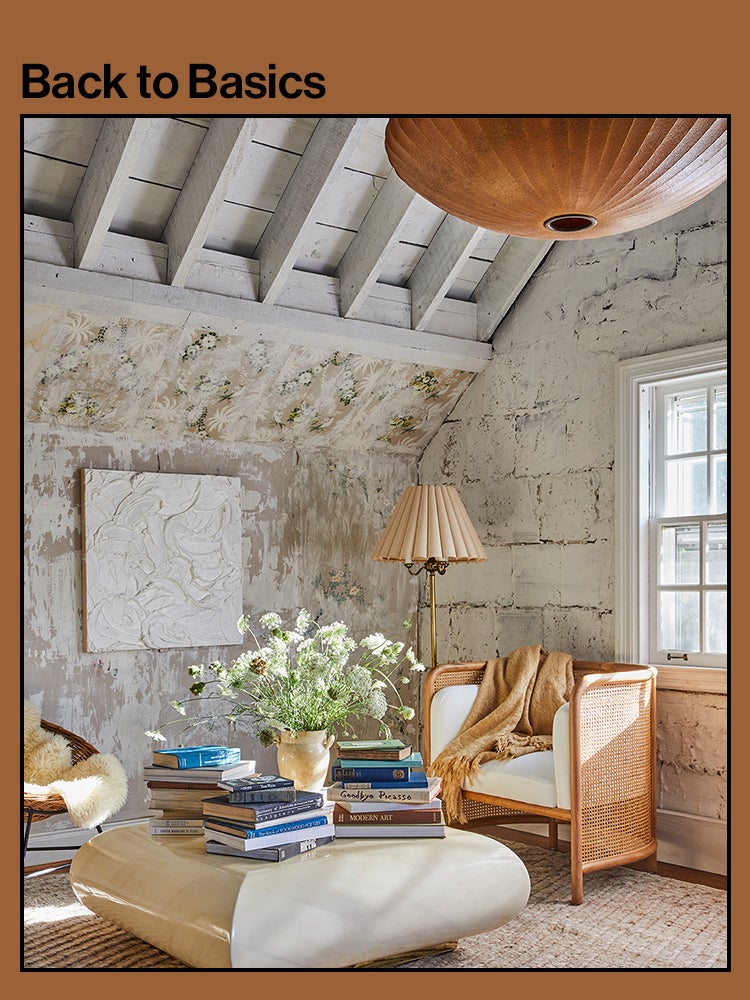How to Paint Over Wallpaper Without It Looking Like a Total Frankenstein
Success is all in the prep.
Published Nov 27, 2021 1:31 AM
We may earn revenue from the products available on this page and participate in affiliate programs.
Removing wallpaper to make way for a fresh coat of paint requires some serious skills. Let’s say your wallpaper installer didn’t use a primer—if you try to tear it off, your drywall will rip out, too. Now you’ve got holes in your wall that need patchwork. Since there isn’t a test out there to gauge how well your wallpaper was applied, painting right over it can actually be less risky, but it totally depends on the wall’s condition. Here’s how to paint over wallpaper—and when to avoid the project altogether.
When to Paint Over Wallpaper
In essence, only when it’s a temporary fix (hello, renters and home stagers!), says Meghan Stewart, senior director of B2C sales at Paintzen; the results are just too unpredictable. There’s no guarantee the paint will dry well or won’t cause a bigger mess when you (or your pets, kids, or furniture) accidentally brush up against it. Plus the process could activate the glue underneath, causing bubbles to form and the wallpaper to unravel. Not a good look.
When You Shouldn’t Paint Over Wallpaper
You can’t paint over wallpaper with edges already unrolling (aka the installation glue has run its course) or any bubbles. And if it’s embossed or patterned, this might show through the paint, warns Stewart. The type of wallpaper also plays a part. Paint may not adhere to a high-gloss finish, so avoid covering something like a peel-and-stick wallpaper. “Chances are, the paint will not cure, drying just on the surface and cracking or chipping in a short amount of time,” Stewart points out.
Hire a Pro or DIY It?
Mike Mundwiller, field development manager at Benjamin Moore, is an advocate for hiring an expert whenever possible. “Since there is no way to predict all the scenarios of a remodel, it’s best to hire a pro,” he says. Someone with experience will be equipped with the know-how to get through unexpected hiccups. Stewart agrees: “It’s not worth the money to redo it in the end.”
If You’re Going Through With It, Test a Sample Area First
Before you commit to the job, paint a small, inconspicuous area and observe it. “Is the paint causing a reaction between the glue or the surface itself? Is anything bleeding through your wallpaper or damaging the overall appearance of the paint?” says Mundwiller. This is especially crucial if you’re using latex paint, which creates tension when it dries and cures. In this case, nothing happening is a good thing.
And Decide on a Primer
Full steam ahead? Decide which primer to use from the get-go. Let your wallpaper type and the results of your sample area guide your purchase. Some primers perform better on top of shiny surfaces, while others work best on wallpapers with darker designs that may bleed through.
And remember, water-based primers are easier to work with versus oil-based primers, which have a more challenging cleanup.
How to Paint Over Wallpaper
The Supplies
- Kraft paper or drop cloths
- Dishwashing detergent and warm water
- Microfiber cloths
- Fresh Start High-Hiding All-Purpose Primer (best for a uniform finish) or Stix Waterborne Bonding Primer (best for glossy or high-sheen wallpapers)
- Spackle
- Putty knife
- Wallpaper glue (optional)
- Tape
- Sandpaper
- Paint roller and extension pole
- Corner edge paint roller (or brush)
- Paint tray
- Painter’s tape
- Paint of choice
- Rags
Step 1: Prep
Set down drop cloths or kraft paper secured with painter’s tape to protect your flooring from errant spills or drips. Then cover any trim, wainscoting, baseboard, or molding you want to keep paint-free with yet more painter’s tape.
Step 2: Clean the Walls
Wipe down the surface with a soap-and-water solution and a sponge, microfiber cloth, or rag. Use just a little—you don’t want to soak the wallpaper. After your surface is dirt- and dust-free, make sure it’s completely dry.
Step 3: Apply a Coat of Primer
Without a primer, the water in the spackle (see step 4) will penetrate differently in one area versus another, which can lead to bubbles and peeling. Applying a coat with your paint roller creates a fresh base.
Step 4: Level the Surface
Using a putty knife, spackle any seams and loose ends to create a flat surface. (You might need to do a skim coat on the entire wall.) If needed, reglue curled ends back down with wallpaper glue. Let dry, then lightly sand the spackled spots for a supersmooth finish. Gently wipe away any dust with a damp microfiber cloth or clean rag.
Step 5: Apply Second Coat of Primer
Prime your surface again using a roller brush (for larger surface areas) and corner brushes (for nooks and crannies), which will seal the surface for the next step.
Step 6: Paint!
Paint the wall with the roller and corner brushes as you would normally, following the paint manufacturer’s instructions.
Step 7: Let Dry
The amount of time the paint takes to dry will depend on where you live and how well ventilated your space is. Give it at least a few days and do a touch test on an unnoticeable corner.

